
There are hundreds of chicken breeds in existence.[1] Domesticated for thousands of years, distinguishable breeds of chicken have been present since the combined factors of geographical isolation and selection for desired characteristics created regional types with distinct physical and behavioral traits passed on to their offspring.
The physical traits used to distinguish chicken breeds are size, plumage color, comb type, skin color, number of toes, amount of feathering, egg color, and place of origin.[1] They are also roughly divided by primary use, whether for eggs, meat, or ornamental purposes, and with some considered to be dual-purpose.[1]

In the 21st century, chickens are frequently bred according to predetermined breed standards set down by governing organizations. The first of such standards was the British Poultry Standard, which is still in publication today.[2][3] Other standards include the Standard of Perfection, the Australian Poultry Standard, and the standard of the American Bantam Association, which deals exclusively with bantam fowl.[3] Only some of the known breeds are included in these publications, and only those breeds are eligible to be shown competitively. There are additionally a few hybrid strains which are common in the poultry world, especially in large poultry farms. These types are first generation crosses of true breeds. Hybrids do not reliably pass on their features to their offspring, but are highly valued for their producing abilities.[1]
| Table of contents |
|---|
|
By place of origin: Afghanistan • Albania • Australia • Austria • Belgium • Brazil • Bulgaria • Canada • Chile • China • Croatia • Cuba • Czech Republic • Egypt • Finland • France • Germany • Greece • Iceland • India • Indonesia • Iran • Italy • Japan • Korea • Kosovo • Malaysia • Myanmar • Netherlands • Norway • Pakistan • Philippines • Poland • Portugal • Romania • Russia • Serbia • Slovakia • Slovenia • South Africa • Spain • Sweden • Switzerland • Thailand • Turkey • Ukraine • United Kingdom • United States • Vietnam |
|
By primary use: Eggs • Meat • Dual-purpose • Exhibition |
By place of origin
[edit]Afghanistan
[edit]Albania
[edit]Australia
[edit]
Austria
[edit]Belgium
[edit]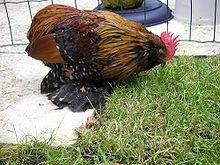
|
|
Brazil
[edit]
Bulgaria
[edit]Canada
[edit]Chile
[edit]China
[edit]
Croatia
[edit]
- Hrvatica (Croatian Hen, Kokoš Hrvatica)[8][9]
- Međimurska kokoš (Međimurje Chicken, Međimurje Hen)[10]
Cuba
[edit]
Cyprus
[edit]Czech Republic
[edit]
|
Egypt
[edit]Finland
[edit]France
[edit]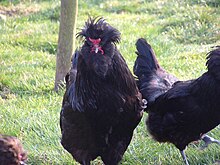


- Aquitaine[17]
- Ardeale[4]
- Ardennaise,
or Sans-queue des Ardennes[17] - Barbezieux[17]
- Blanzac[4]
- Bourbonnaise[17]
- Bourbourg[17]
- Bresse Gauloise[17]
- Caumont[17]
- Caussade[17]
- Charollaise[17]
- Cocherelle[4]
- Combattant du Nord[17]
- Contres[17]
- Cotentine[17]
- Coucou des Flandres[17]
- Coucou de France[17]
- Coucou de Rennes[17]
- Coucou Picarde[4]
- Coucou Soie[4]
- Cou-nu du Forez[17]
- Courtes-Pattes[17]
- Crèvecœur
- Estaires[17]
- Faverolles clair (light)[17]
- Faverolles foncée
(dark, or "German" Faverolles)[17] - Favoris[4]
- Gasconne[17]
- Gâtinaise[17]
- Gauloise dorée[17]
- Géline de Touraine[17]
- Gournay[17]
- Hergnies[17]
- Houdan[17]
- Ivanaise[4]
- Janzé[17]
- Javanaise[17]
- La Flèche
- Landaise[17]
- Le Mans[17]
- Le Merlerault[17]
- Meusienne[17]
- Limousine (coq de pêche)[17]
- Lyonnaise[17]
- Mantes[17]
- Marans[17]
- Noire du Berry[17]
- Noire de Challans[17]
- Pavilly[17]
- Poule d'Alsace[17]
- Poule de Caux[4]
- Poule de Marquise[4]
- Poule de Saint-Omer[4]
- Poule des Courrières[4]
- Poule des haies, see Ardennaise[4]
- Provençale[4]
Germany
[edit]
(illustration by Jean Bungartz, 1885)

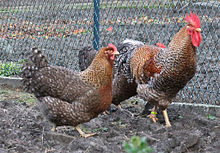
Large breeds
[edit]- Annaberger Haubenstrupphühner[18][19]
- Augsburger[18][19]
- Bergische Kräher,[18][19]
- Bergische Schlotterkämme[18][19]
- Bielefelder Kennhuhn[18][19]
- Deutsches Lachshuhn,[18]
see Faverolles[19] - Deutsche Langschan,[18]
see German Langshan[19] - Deutsches Reichshuhn[18][19]
- Deutsche Sperber[18][19]
- Dresdner[18][19]
- German creeper[18][19]
- Hamburger,[18]
see Hamburg[19] - Kraienköppe (Twents hoen)[19]
- Lakenfelder,[18]
seeLakenvelder[19] - Nackthalshühner, see Naked-neck[19]
- Niederrheiner[18][19]
- Ostfriesische Möwen,[18][19]
seeEast Frisian Gull - Pfälzer Kämpfer[19]
- Phoenix[19]
- Ramelsloher[18][19]
- Rheinländer[18][19]
- Sachsenhuhn[18][19]
- Strupphuhn, see Frizzle[19]
- Sultanhuhn, see Sultan[19]
- Sundheimer[18][19]
- Thüringer Barthuhn[18][19]
- Vogtländer[18][19]
- Vorwerkhuhn,[18]
seeVorwerk[19] - Westfälische Totleger,[18][19]
seeWestphalian chicken
Bantams
[edit]- Bergische Zwerg-Kräher[19][20]
- Bergische Zwerg-Schlotterkämme[19][20]
- Bielefelder Zwerg-Kennhühner[19][20]
- Brügger Zwerg-Kämpfer[20]
- Deutsche Zwerghühner[19][20]
- Deutsche Zwerg-Lachshühner,[20]
see Faverolle Bantam[19] - Deutsche Zwerg-Langschan,[20]
see German Langshan Bantam[19] - Deutsche Zwerg-Reichshühner[19][20]
- Deutsche Zwerg-Sperber[19][20]
- Frankfurter Zwerghühner[19][20]
- Ostfriesische Zwerg-Möwen[19][20]
- Ruhlaer Zwerg-Kaulhühner[19][20]
- Siamesisches Zwerg-Seidenhühner[19][20]
- Thüringer Zwerg-Barthühner[19][20]
- Zwerg-Altsteirer[19][20]
- Zwerg-Amrocks[19][20]
- Zwerg-Andalusier,[19][20]
see Andalusian[19] - Zwerg-Araucana,[20]
see Rumpless Araucana Bantam[19] - Zwerg-Asil,[19] see Asil Bantam
- Zwerg-Augsburger,[20]
see Augsburger Bantam[19] - Zwerg-Australorps,[20]
see Australorp Bantam[19] - Zwerg-Barnevelder,[20]
see Barnevelder Bantam[19] - Zwerg-Brahma,[20]
see Brahmas[19] - Zwerg-Brakel,[20]
see Brakel Bantam[19] - Zwerg-Créve Coeur,[20]
see Crevecoeur Bantam[19] - Zwerg-Dominikaner,[20]
see Dominique Bantam[19] - Zwerg-Dresdner[19][20]
- Zwerg-Hamburger, see Hamburg Bantam[19]
- Zwerg-Italiener,[20]
see Leghorn Bantam[19] - Zwerg-Kastilianer[19][20]
- Zwerg-Krüper[19][20]
- Zwerg-La Fléche,[20]
see La Fleche Bantam[19] - Zwerg-Lakenfelder,[20]
see Lakenfelder Bantam[19] - Zwerg-Minorka,[20]
see Minorca Bantam[19] - Zwerg-Nackthalshühner,[20]
see Naked-neck bantam - Zwerg-New Hampshire
see New Hampshire Bantam[19] - Zwerg-Niederrheiner[19][20]
- Zwerg-Orloff,[20]
see Orloff Bantam[19] - Zwerg-Orpinglon[20]
see Orpington Bantam[19] - Zwerg-Phönix,[20]
see Phoenix[19] - Zwerg-Plymouth Rocks,[20]
see Plymouth Rock Bantam[19] - Zwerg-Rheinländer[19][20]
- Zwerg-Rhodeländer[19][20]
- Zwerg-Sachsenhühner[19][20]
- Zwerg-Sulmtaler,[20]
see Sulmtaler Bantam[19] - Zwerg-Sundheimer[19][20]
- Zwerg-Sussex,[20]
see Sussex Bantam[19] - Zwerg-Vorwerkhühner[20]
see Vorwerk Bantam[19] - Zwerg-Welsumer[20]
see Welsumer Bantam[19] - Zwerg-Yokohama[20]
see Yokohama Bantam[19]
Greece
[edit]Iceland
[edit]India
[edit]
Indonesia
[edit]
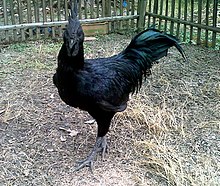
|
|
Iran
[edit]
|
Italy
[edit]
Japan
[edit]
|
Korea
[edit]Kosovo
[edit]- Kosova Long-crowing[30] (also called Tringjyrshet Kosov)

Malaysia
[edit]Mariana Islands
[edit]Myanmar
[edit]Netherlands
[edit]
|
|
Norway
[edit]Pakistan
[edit]Philippines
[edit]Poland
[edit]- Polbar[4]
- Zielononóżka Kuropatwiana (Green-legged Partridge)[4]
- Polish chicken
Portugal
[edit]Romania
[edit]

Russia
[edit]Serbia
[edit]
|
|
Slovakia
[edit]Slovenia
[edit]South Africa
[edit]Spain
[edit]

|
|
Sweden
[edit]Switzerland
[edit]
Taiwan
[edit]Thailand
[edit]- Gai Chon[45]
- Gai Puen Muang[45]
- Pradu Hang Dum[45] or Pradu Hang Dam Chiangmai[46]
- Thai Game[47]
Turkey
[edit]
Ukraine
[edit]United Kingdom
[edit]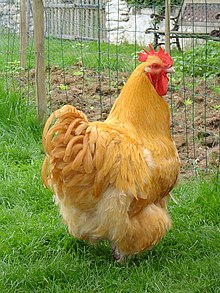
United States of America
[edit]
|
Vietnam
[edit]By primary use
[edit]All chickens lay eggs, have edible meat, and possess a unique appearance. However, distinct breeds are the result of selective breeding to emphasize certain traits. Any breed may be used for general agricultural purposes, and all breeds are shown to some degree. But each chicken breed is known for a primary use.
Eggs
[edit]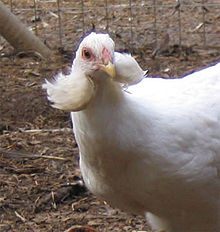
Many breeds were selected and are used primarily for producing eggs, these are mostly light-weight birds whose hens do not go broody often.
|
Meat
[edit]Most farms and homesteads use dual-purpose breeds for meat production. Some breeds are raised mainly for meat:
Dual-purpose
[edit]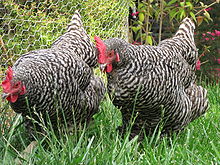
Plymouth Rock breed
The generalist breeds used in barnyards worldwide are adaptable utility birds good at producing both meat and eggs. Though some may be slightly better for one of these purposes, they are usually called dual-purpose breeds.
Exhibition
[edit]Since the 19th century, poultry fancy, the breeding and competitive exhibition of poultry as a hobby, has grown to be a huge influence on chicken breeds. Many breeds have always been kept for ornamental purposes, and others have been shifted from their original use to become first and foremost exhibition fowl, even if they may retain some inherent utility. Since the sport of cockfighting has been outlawed in the developed world, most breeds first developed for this purpose, called game fowl, are now seen principally in the show ring rather than the cock pit as fighting cocks.
| Key |
|---|
|
U denotes a breed primarily used for exhibition, but which is still used for utility purposes. |
|
G denotes a game breed. |
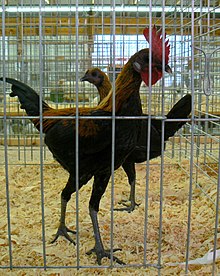
Bantams
[edit]
Most large chicken breeds have a bantam counterpart, sometimes referred to as a miniature. Miniatures are usually one-fifth to one-quarter the size of the standard breed, but they are expected to exhibit all of the standard breed's characteristics. A true bantam has no large counterpart, and is naturally small. The true bantams include:
Crossbreeds
[edit]Many common strains of crossbred chickens exist, but none breed true or are recognized by poultry breed standards; thus, though they are extremely common in flocks focusing on high productivity, crossbreeds do not technically meet the definition of a breed. Most crossbreed strains are sex linked, allowing for easy chick sexing.
|
See also
[edit]Footnotes
[edit]- ^ Czech language names Czech gold brindle chicken include Česká slepice zlatě kropenatá, Česká zlatá kropenka, and Češka.[11][12]
- ^ The original breed of bantam chicken is ancestor to all "bantam" breeds. It originated in Indonesia and there is called Ayam Kate.
References
[edit]- ^ a b c d Ekarius (2007), p. 23
- ^ a b Ekarius (2007)
- ^ a b Heinrichs (2007)
- ^ a b c d e f g h i j k l m n o p q r s t u v w x y z aa ab ac ad ae af ag ah ai aj ak al am an ao ap aq ar as at au av aw ax ay az ba bb bc bd be bf bg bh bi bj bk bl bm bn bo bp bq br bs bt bu bv bw bx by bz ca cb cc cd ce cf cg ch ci cj ck cl cm cn co cp cq cr cs ct cu cv cw cx cy cz da db dc dd de df dg dh di dj dk dl dm dn do dp dq dr ds dt du dv dw dx dy dz ea eb ec ed ee ef eg eh ei ej ek el em
"Domestic Animal Diversity Information System". Food and Agriculture Organization. United Nations. Retrieved 1 January 2012. - ^ "Altsteirer". Poultry. Feathersite.com. Retrieved 1 January 2012.
- ^ a b c d e f g h i j k l m n o p
Rousseau, Jaak. "Grandes volailles". Large poultry breeds. telenet.be. Association pour la Promotion des Animaux de Basse-cour Belges (in French). Archived from the original on 2018-09-23. Retrieved 1 January 2012. - ^ a b c d e f g h i j k l m n o p q r s t
Rousseau, Jaak. "Volailles naines". Dwarf poultry breeds. telenet.be. Association pour la Promotion des Animaux de Basse-cour Belges (in French). Archived from the original on 2018-09-23. Retrieved 1 January 2012. - ^ "Croatian hen". Poultry. Feathersite.com. Retrieved 1 January 2012.
- ^ Croatia Country Report (PDF). rfp-europe.org (Report). European RFP. 2009.
- ^ "Međimurska kokoš". Poultry. agroportal.hr. Retrieved 2 June 2024.
- ^ a b Gardianova (PDF). EAAP Annual Meeting. eaap.org. Papers. Vol. 01. Barcelona, ES. 2009. Archived from the original (PDF) on 2014-05-25. Retrieved 2012-08-12.
- ^ a b c "Czech chicken breeds". ceske-slepice.eu. Retrieved 1 January 2012.
- ^ "Biodiversity in the Czech Republic". Animal genetic resources. Enrin.grida.no. Archived from the original on 4 March 2016. Retrieved 1 January 2012.
- ^ a b c d e f g h i j k l m Nikkonen, Terhi (14 June 2011). Finnish AnGR conservation programme: What and how? (PDF). MTT Agrifood Research Finland. Workshop 14 June 2011. documents.plant.wur.nl. Seminars. Retrieved 1 January 2012 – via Wageningen University & Research, Wageningen, NL.
- ^ "Finnish chickens". Poultry. Feathersite.com. Retrieved 1 January 2012.
- ^ "Finnish National Animal Genetic Resources Program". Each country's efforts / Nordic conservation. Nordgen.org. InnehĂĽll / Farm Animals. Nordic Genetic Resource Center. Archived from the original on 2012-01-22. Retrieved 1 January 2012.
- ^ a b c d e f g h i j k l m n o p q r s t u v w x y z aa ab ac ad ae af ag ah ai aj ak al am an ao
"French fowl". pagesperso-orange.fr. Fédération française des volailles. Volaille Poultry. Archived from the original on 2016-03-05. Retrieved 1 January 2012. - ^ a b c d e f g h i j k l m n o p q r s t u v w
"Hühner 2011". Chickens 2011. Bund Deutscher Rassegeflügelzüchter (in German). Archived from the original on 2016-03-05. Retrieved 1 January 2012. - ^ a b c d e f g h i j k l m n o p q r s t u v w x y z aa ab ac ad ae af ag ah ai aj ak al am an ao ap aq ar as at au av aw ax ay az ba bb bc bd be bf bg bh bi bj bk bl bm bn bo bp bq br bs bt bu bv bw bx by bz ca cb cc cd ce
"Listing of European poultry breeds and colours [for] 2013". entente-ee.com (in German). Archived from the original on 2013-06-16. - ^ a b c d e f g h i j k l m n o p q r s t u v w x y z aa ab ac ad ae af ag ah ai aj ak al am an ao ap aq ar as at au
"Zwerghühner 2011". Dwarf chickens 2011. bdrg.de (media archive). Bund Deutscher Rassegeflügelzüchter (in German). Archived from the original on 2016-03-21. Retrieved 1 January 2012. - ^ "Alonissos island chicken". Arca-Net.info. Breed Atlas. Archived from the original on 12 December 2019. Retrieved 1 September 2023.
local name 'double-yolk chicken'
- ^ "Chios fighting chicken". Arca-Net.info. Breed Atlas. Archived from the original on 23 September 2015. Retrieved 1 September 2023.
local name 'Nysiriotiko'
- ^ "Follidotes chicken". Arca-Net.info. Breed Atlas. Archived from the original on 23 September 2015. Retrieved 1 September 2023.
- ^ "Kalamata chicken". Arca-Net.info. Breed Atlas. Archived from the original on 12 December 2019. Retrieved 1 September 2023.
- ^ "Pomak fighting chicken". Arca-Net.info. Breed Atlas. Archived from the original on 23 September 2015. Retrieved 1 September 2023.
- ^ "Lesvos Fillianes chicken". Arca-Net.info. Breed Atlas. Archived from the original on 23 September 2015. Retrieved 1 September 2023.
- ^ "Trikala chicken". Arca-Net.info. Breed Atlas. Archived from the original on 2015-09-23. Retrieved 2023-09-01.
local name Gyftokokoras ("gypsy chicken")
- ^ Percy (2006), p. 17
- ^ a b c d e f g h i j k l m n o p q r s t u
"Atlante delle razze * di polli" [Atlas of chicken breeds]. agraria.org (in Italian). Retrieved 1 January 2012. - ^ "Kosova long-crowing rooster". Poultry. feathersite.com. Retrieved 18 July 2012.
- ^ a b c d e f g h i j k l m n o p q r s t
"Hoenders en dwerghoenders". Chickens and dwarf chickens. Nederlandse Bond van Hoender, Dwerghoender, Sier- en Watervogelhouders (in Dutch). Archived from the original on 2007-07-17. Retrieved 1 January 2012. - ^ a b c d e
"Chicken breeds reported by Philippines". dad.fao.org. Domestic Animal Diversity Information System of the Food and Agriculture Organization. United Nations. Retrieved 1 June 2014. - ^ a b c d e
Bejar, Feleciano R.; Baylon, Manuel J.; Fabillar, Jaime B.; Mante, Lagrito Ebert B.; Ultra, Arturo A.; Aquino, Reynaldo R.; Bejar, Elvie T. (2012). Management Practices and Morphological Characterization of Indigenous (Native) Chickens in Samar Province. searca.org (Report). Agriculture & Development Discussion Paper. Vol. 2012–3. Los Baños, Laguna, Philippines: Southeast Asian Regional Center for Graduate Study and Research in Agriculture. Archived from the original on 2014-06-15. - ^ a b c d
"Aves" [Birds]. amiba.com.pt. Associação dos Criadores de Bovinos de Raça Barrosã (in Portuguese). Archived from the original on 2012-01-21. Retrieved 1 January 2012. - ^ "Banatski gološijan standard" (in Serbian). Sremska Mitrovica: Udruzenje za zastitu i odgoj sitnih zivotinja [Association for the protection and upbringing of small animals]. Archived from the original on 2013-02-01. Retrieved 1 January 2012.
- ^ "Svrljig Kokos". agrobiodiversity.net. Balkan Network for Agrobiodiversity (in Bosnian). Retrieved 1 January 2012.
- ^ a b c d
Slovenske avtohtone in tradicionalne pasme domačih živali [Slovenian native and traditional breeds of farm animals] (PDF). genska-banka.si (Report). Oddelek za zootehniko, UL BF (in Slovenian). 2014. Retrieved 22 Oct 2021. - ^ Holcman, Antonija (19 July 2021). "Styrian chickens". Poultry breeds / Breeds of Livestock. afs.okstate.edu. Department of Animal Science. Stillwater, OK: Oklahoma State University. Retrieved 2021-10-22.
- ^ a b c
Strelec, Alenka; Terčič, Dušan; Malovrh, Špela; Holcman, Antonija (2009). "Prireja in fizikalne lastnosti jajc slovenskih tradicionalnih pasem kokoši lahkega tipa" [Preparation and physical properties of eggs of Slovenian traditional breeds of light-type hens]. Acta Agriculturae Slovenica (in Slovenian). 1: 5–12. - ^ Kobold, Primož (2017). "Primerjava proizvodnosti piščancev ross 308 in slovensko pozno operjene kokoši v pogojih ekološke reje" [Comparison of productivity of Ross 308 chickens vs. Slovenian late-plucked hens under organic farming conditions]. dk.um.si (in Slovenian). Maribor, SL: University of Maribor. Retrieved 2021-12-05.
- ^ a b c
"The indigenous poultry breeds of South Africa". Agricultural Research Council. Pretoria, ZA: Department of Agriculture. Archived from the original on 2011-09-28. - ^ a b c d e f g h i j k l
"Catálogo oficial de razas de ganado de España" [Official catalog of Spain's livestock breeds]. Ganaderia [livestock] (in Spanish). Madrid, ES: Ministerio de Agricultura, Pesca y Alimentación. Archived from the original on 25 September 2022. - ^ "Asociacion Cántabra ..." (main page). Asociacion Cántabra para la Conservación y Fomento de la Gallina Pedresa.
- ^ "Taiwanese Shamo". United Kingdom of Great Britain and Northern Ireland (chicken) (breed data sheet). Domestic Animal Diversity Information System of the Food and Agriculture Organization. United Nations. Retrieved 1 April 2022.
- ^ a b c "Chicken". Breeds reported by Thailand. Domestic Animal Diversity Information System of the Food and Agriculture Organization. United Nations. Retrieved 1 June 2016.
- ^ "Pradu Hang Dam Chiangmai" ไก่ประดู่หางดำเชียงใหม่ [Chiang Mai black-tailed Pradu chicken]. Chicken breed. Poultry Research and Development Section (in Thai). Thailand: Bureau of Animal Husbandry and Genetic Improvement, Department of Livestock Development. Archived from the original on 2014-01-08. Retrieved 2014-01-08.
- ^ Roberts (2008), p. 296
- ^ "Denizli rooster". Kultur.Gov.Tr. Department of Culture and Tourism. Republic of Turkey. Retrieved 16 June 2014.
Sources
[edit]- Ekarius, Carol (2007). Storey's Illustrated Guide to Poultry Breeds (complete ed.). North Adams, MA: Storey Publishing. ISBN 9781580176675 – via archive.org.
- Heinrichs, Christine (2007). How to Raise Chickens. St. Paul, MN: Voyageur Press. ISBN 978-0-7938-0601-0 – via archive.org.
- Percy, Pam (2006). The Field Guide to Chickens. St. Paul, MN: Voyageur Press. ISBN 0-7603-2473-5 – via Google Books.
Roberts, Victoria (2008). British Poultry Standards. Oxford, UK: Blackwell. ISBN 9781405156424. Complete specifications and judging points of all standardized breeds and varieties of poultry as compiled by the specialist breed clubs and recognised by the Poultry Club of Great Britain.